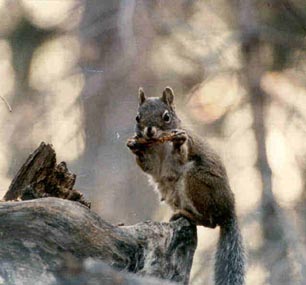
|
 |
 |

|
 |
 |
As part of our long-term monitoring efforts we, The Mount Graham Red Squirrel Monitoring Program, have conducted conifer seed availability and mushroom availability studies since the early 1990's.
A series of seed traps were set out at randomly placed plots in July 1993, and seeds have been collected and identified each spring (following snow-melt) to determine total seed fall for a year. The number of seeds/m2 for each species is determined for each trap, the average seed fall for each plot is extrapolated to seeds/ha. Seed fall has been measured since the 1993 cone crop and has allowed us to quantify the good spruce crops of 1993 and 1995. The seeds of white pine and ponderosa pine are not readily dispersed by wind due to their large size. Because of this, the crops of these species are under represented in the seed trap samples. Both of these species may be important local food supplies for red squirrels, but at present there is no reliable method for estimating the size of the crops. This project will continue through at least one more major spruce crop in order to better understand the size of the crops and their periodicity.
Biomass measurements are used to compare mushroom productivity differences between habitats and between construction and non-construction areas, which helps define the food availability for Mount Graham red squirrel populations. All mushrooms found within established transects are plucked from the stalk base or fruiting base, weighed (to the nearest 0.1g), and identified to genus using diagnostic macroscopic and microscopic characteristics. The mean annual mushroom production is extrapolated from the transect data as Kg wet weight/ha.

This site maintained by the Mt. Graham Biology Program - The University of Arizona.
If you have any questions or comments please email us at:RSMP@ag.arizona.edu